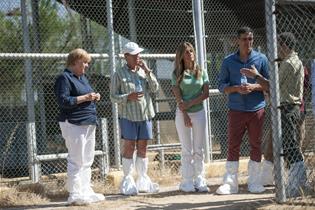Pedro Sánchez and Angela Merkel visited the centre's facilities in Doñana on Sunday morning
President of the Government and German Chancellor visit El Acebuche breeding centre, a benchmark in conservation of Iberian lynx
President's News - 2018.8.12
1. Images of the visit to the El Acebuche breeding centre (part 1)Pool Moncloa / Juan Luis Lorch2018.8.12
El Acebuche, Almonte, Huelva
The two leaders toured the El Acebuche breeding in captivity centre's facilities on Sunday, a pioneer of the Ex-situ Conservation Program of the Iberian Lynx, where the first litter of this species was born in captivity on 28 March 2005.
There are now four breeding centres on the Iberian Peninsula, two of them run by the Independent National Parks Authority, which falls under the Ministry for Ecological Transition, El Acebuche in Huelva and Zarza de Granadilla in Caceres. There is also La Olivilla in Jaen, run by the Regional Government of Andalusia and the Silves Centre in Portugal. Eight of the 29 lynxes evacuated because of the fire in the Algarve were brought to El Acebuche on Thursday from the Portuguese centre, in addition to another nine taken in by the centre in Zarza de Granadilla and 12 in La Olivilla.
During their visit, Pedro Sánchez and Angela Merkel were able to see these lynxes that had been rescued from the Portuguese breeding centre on the surveillance cameras controlling the feeding area where these animals are located. Francisco Villaespesa, Director of the El Acebuche centre and Coordinator of the Ex-situ Conservation Program of the Iberian Lynx, accompanied the two leaders in their visit and explained to them the situation of the lynxes, which are relaxed and in a good state of health. The President of the Government and the Chancellor also visited other enclosures at the centre that work to conserve a shared natural heritage.
Success of the breeding in captivity program
 Pool MoncloaAlthough the species continues to be listed by the International Union for Conservation of Nature as 'endangered' and it continues to be the most threatened species of feline on the planet, the current situation is far from what it was at the end of 2003, when the breeding program for the Iberian lynx began.
Pool MoncloaAlthough the species continues to be listed by the International Union for Conservation of Nature as 'endangered' and it continues to be the most threatened species of feline on the planet, the current situation is far from what it was at the end of 2003, when the breeding program for the Iberian lynx began.
At that time it was estimated that there were fewer than 100 lynxes on the planet - of which only half were adults with the potential to reproduce - distributed between two completely separate populations: Doñana and Sierra Morena. The species was in real danger of extinction, a situation in which a simple stroke of bad luck (epidemic, wildfire, etc) could have led the Iberian lynx to extinction.
At present, and since the first litter was born in captivity on 28 March 2005 at the El Acebuche centre, 485 cubs have been born through the network of breeding centres in the program, of which 236 were born at centres run by the Independent National Parks Authority - 146 in El Acebuche and 90 in Zarza de Granadilla.
The breeding season ended a few weeks ago with a positive balance of 39 cubs, 11 of them in El Acebuche. The survival rate of cubs was 80%, higher than the average survival rate over the last 14 years of the program, which stands at 75%. Since 2005, 215 animals have been released into their natural environment under the breeding program, doubling the initial estimate of the action plan for breeding in captivity, which set the number of cubs to be freed by 2018 at 104.
Non official translation





